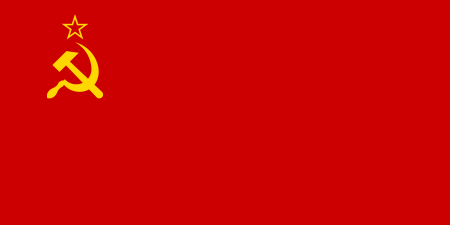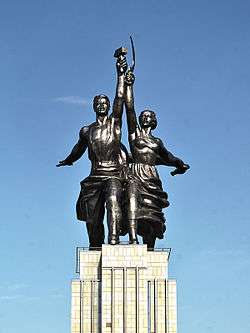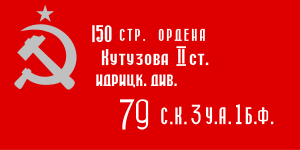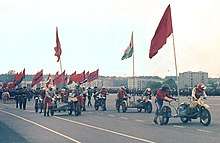Flag of the Soviet Union
The State Flag of the Union of Soviet Socialist Republics (Russian: Госуда́рственный флаг Сою́за Сове́тских Социалисти́ческих Респу́блик, tr. Gosudárstvenny flag Soyúza Sovétskikh Sotsialistícheskikh Respúblik), commonly known as the Soviet flag (Russian: Сове́тский флаг, tr. Sovétsky flag), was the official national flag of the Union of Soviet Socialist Republics (USSR) from 1922 to 1991. The flag's design and symbolism are derived from several sources, but emerged during the Russian Revolution. The flag is also an international symbol of the communist movement as a whole. The nicknames for the flag were The Hammer and Sickle and The Red Banner.
 | |
| Names | Flag of the Soviet Union, The Hammer and Sickle; The Red and Gold; The Red Banner[1] |
|---|---|
| Use | State flag, civil and state ensign |
| Proportion | 1:2 |
| Adopted | December 1922 (original version) 19 August 1955 (last version used) |
| Relinquished | 26 December 1991 |
| Design | A plain red flag with a golden hammer and sickle and a gold-bordered red star in its upper canton. |
| Part of a series on the |
| Culture of the Soviet Union |
|---|
 |
| People |
| Languages |
| Traditions |
| Cuisine |
| Festivals |
|
Art |
| Literature |
|
Music and performing arts |
| Sport |
|
Monuments |
|
Symbols
|
|
The design is a solid field of red adorned with a unique gold emblem in the upper hoist quarter. The red flag was a traditional revolutionary symbol long before 1917, and its incorporation into the flag paid tribute to the international aspect of workers' revolution. The iconic hammer and sickle design was a modern industrial touch adopted from the Russian Revolution. The union of the hammer (workers) and the sickle (peasants) represents the victorious and enduring revolutionary alliance. The famous emblem is topped by a gold-bordered red star representing the Communist Party of the Soviet Union.
The first flag was adopted in December 1922. In 1955, a statute on the flag was adopted which resulted in a change of the hammer's handle length and the shape of the sickle. This was the final modification to the flag and it continued to be the official national flag until the dissolution of the Soviet Union.[3]
Its imagery is now the basis for the flags of many communist parties: a yellow hammer and sickle on a red background.
Today, the flag is used in communist rallies and protests and those nostalgic for the Soviet Union.
Symbolism and design
The flag of the Soviet Union consisted of a plain red flag with a gold hammer crossed with a gold sickle placed beneath a gold-bordered red star. This symbol is in the upper left canton of the red flag.
The colour red honours the red flag of the Paris Commune of 1871 and the red star and hammer and sickle are symbols of communism and socialism.
The hammer symbolises urban industrial workers while the sickle symbolises agricultural workers (peasants)—who together, as the Proletarian class, form the state. The red star represents the Communist Party, and its position over the hammer and sickle symbolises its leading role in socialist society to unify and enlighten the workers and peasants in the building of communism.
.svg.png)
The flag's design was legislated in 1955, which gave a clear way to define and create the flag. This resulted in a change of the hammer's handle length and the shape of the sickle. The adopted statute stated that:[4]
- The ratio of width to length of the flag is 1:2.
- The hammer and sickle are in a square with sides equal to 1⁄4 of the flag's height. The sharp tip of the sickle lies in the center of the upper side of the square, and the handles of the hammer and sickle rest in the bottom corners of the square. The length of the hammer and its handle is 3⁄4 of the square diagonal
- The five-pointed star is inscribed into a circle with a diameter of 1⁄8 of the flag's height, the circle being tangent to the upper side of the square.
- The distance of the vertical axis of the star, hammer and sickle from the hoist is 1⁄3 of the flag's height. The distance from the upper side of the flag to the center of the star is 1⁄8 of the flag's height.

.svg.png)
Officially since 1980, the reverse side of the flag was a plain red field without the hammer and sickle. In practice however, this was very commonly disregarded by flag makers as it was far easier and less costly to simply print the flag through and through, with the obverse design mirrored on the reverse.[5] It was also common to see the reverse of the flag bear the hammer and sickle in the obverse formation.[6] An example of the flag demonstrating its de jure status as being only one-sided is that of the Soviet flag atop the Moscow Kremlin which bore the single-side official design.
For vertical display, the flag was made with the distinct difference of having the hammer and sickle rotated 90 degrees in order to compensate for the change in dimensions. This was common in official practice, however the common flag owner would simply hang the standard design of the flag by the hoist.[7]
During the presidency of Vladimir Putin, the Soviet flag is not only used for communism, but as a symbol for Soviet nostalgia, which became a major global superpower that developed nuclear weapons and sent the first satellites, animals, and people into space. It also symbolizes the sacrifices of the Soviet people and soldiers that perished in the Great Patriotic War as well as against fascism.
Colours scheme
| Red | Gold | |
|---|---|---|
| RGB | 205/0/0 | 255/217/0 |
| Hexadecimal | #CD0000 | #FFD900 |
| CMYK | 0/100/100/20 | 0/15/100/0 |
| Pantone (approximate) | 3546 C | Medium Yellow C |
History
During the establishment of the Russian Soviet Republic, Vladimir Lenin and his comrades had considered the inclusion of a sword symbol in addition to the hammer and sickle as part of the state seal on which the flag was eventually based. The idea was dismissed as too visually aggressive, with Lenin apparently affirmed, "A sword is not one of our symbols."[8]
The first official flag was adopted in December 1922 at the First Congress of Soviets of the USSR. It was agreed that the red banner 'was transformed from the symbol of the Party to the symbol of a state, and around that flag gathered the peoples of the soviet republics to unite into one state — the Union of Soviet Socialist Republics'. On 30 December 1922, the Congress adopted a Declaration and Agreement on the establishment of the USSR. Article 22 of the Agreement states: 'the USSR has a flag, coat of arms and a state seal.' The description of the first flag was given in the 1924 Soviet Constitution, accepted in the second session of the Executive Committee (CIK) of the USSR on 6 July 1923. The text of article 71 states: 'The state flag of the Union of Soviet Socialist Republics consists of a red or scarlet field with states coat of arms'. It was ordered with the unusual ratio of 4:1 in proportion and consisted of a red flag with the state coat of arms in the center. However, such a flag was never mass-produced. This flag was the official flag for four months, and was replaced as the official flag by the more familiar hammer and sickle design during the third session of the CIK of the USSR on 12 November 1923.
In the third session of the CIK of the USSR, the description of Soviet flag in the Constitution was changed, and article 71 was edited to be: 'The state flag of the Union of Soviet Socialist Republics consists of a red or scarlet field, and in the canton a golden sickle and hammer, and a red five-pointed star bordered in gold above them. The ratio of width to length is 1:2.' On 19 August 1955 "Statute on the State Flag of the Union of Soviet Socialist Republics" was adopted by a decision of the Presidium of the Supreme Soviet of the USSR. This resulted in a change of the hammer's handle length and the shape of the sickle. On August 15, 1980, a new edition of the "Statute on the State Flag of the Union of Soviet Socialist Republics" was adopted, which did not make any changes to the flag's description aside from removing the hammer and sickle on the reverse side of the flag.[3] From this point on, the flag stayed in use with this design until the disintegration of the USSR on 26 December 1991, at which time it ceased to be a national flag and replaced by national flags of the post-Soviet republics.
Today, the Soviet flag is used by the opposition, mainly left-wing rallies and demonstrations in the former Soviet space. The flags often used are those of the union republics (in particular those where the demonstrations are held).
.svg.png) December 1922
December 1922
—
12 November 1923.svg.png) 12 November 1923
12 November 1923
—
18 April 1924.svg.png) 18 April 1924
18 April 1924
—
5 December 1936.svg.png) 5 December 1936
5 December 1936
—
19 August 1955 19 August 1955
19 August 1955
—
26 December 1991
Similarities with other flags

The Soviet Union was the world's first constitutionally socialist state, making it the inspiration of future socialist states. This led to the inspirations for the flags of the Republic of Angola, the People's Republic of China, the Democratic People's Republic of Korea, and the Socialist Republic of Vietnam.
The flags of the Soviet republics that constituted the USSR were all defaced or modified versions of the Soviet flag.
On 15 April 1996 Boris Yeltsin signed a presidential decree giving the Soviet flag (called the Victory Banner, after the banner that was raised above the Reichstag on 1 May 1945) status similar to that of the national flag. The hammer and sickle were removed from the flag, leaving only the star, but they were reinstated later. On certain holidays, the Victory Banner is flown along with the Russian flag.
Military flags

 An example of Red Army regimental colours, which the unofficial army flag was based on[10]
An example of Red Army regimental colours, which the unofficial army flag was based on[10].svg.png) Ensign of the Soviet Navy
Ensign of the Soviet Navy Flag of the Soviet Air Forces
Flag of the Soviet Air Forces
Gallery
 Official construction sheet for the State Flag of the USSR
Official construction sheet for the State Flag of the USSR.jpg) The Soviet flag along with an assortment of Russian and Soviet military flags
The Soviet flag along with an assortment of Russian and Soviet military flags.jpg) The State Flag of the USSR flown atop the Belarusian Great Patriotic War Museum
The State Flag of the USSR flown atop the Belarusian Great Patriotic War Museum The State Flag of the USSR (pictured in the foreground) leading the parade with flags of all 15 Soviet republics following from behind during a Victory Day parade in 1984
The State Flag of the USSR (pictured in the foreground) leading the parade with flags of all 15 Soviet republics following from behind during a Victory Day parade in 1984 The last Soviet flag shown at the Checkpoint Charlie Museum, in Berlin. This flag was manufactured with an unofficial hammer and sickle design
The last Soviet flag shown at the Checkpoint Charlie Museum, in Berlin. This flag was manufactured with an unofficial hammer and sickle design
See also
References
- Whitney Smith (2008). "Flag of Flag of Union of Soviet Socialist Republics". Encyclopædia Britannica. Retrieved 2008-11-05.
- Whitney., Smith (1980). Flags and arms across the world. Smith, Whitney. New York: McGraw-Hill. pp. 203. ISBN 9780070590946. OCLC 4957064.
- Russian Centre of Vexillology and Heraldry. "Флаги СССР". vexillographia.ru. Archived from the original on 21 February 2014. Retrieved 11 January 2019.
- USSR Supreme Soviet Presidium (19 August 1955). Положение о государственном флаге СССР (in Russian). Retrieved 2008-11-05.
- "Construction details of Soviet flags". flagspot.net. Retrieved 2017-11-18.
- "Reverse of the flag - Soviet Union". flagspot.net. Retrieved 2017-11-18.
- "Vertical hoisting – Soviet Union". flagspot.net. Retrieved 2017-12-05.
- Konstantin AndreevichIvanov (1971). Flags of the states of the world (in Russian). Moscow: Izd-vo Transport. p. . OCLC 20146023.
- FOTW - Army flags of the Soviet Union: There were only regimental (division etc.) colours in Soviet Army. This is an unofficial army flag used in artworks.
- FOTW - Regimental colours
External links
| Wikimedia Commons has media related to Flags of the Soviet Union. |

